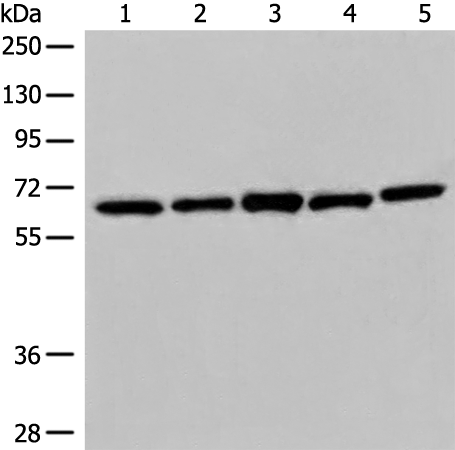
| WB | 咨询技术 | Human,Mouse,Rat |
| IF | 咨询技术 | Human,Mouse,Rat |
| IHC | 咨询技术 | Human,Mouse,Rat |
| ICC | 技术咨询 | Human,Mouse,Rat |
| FCM | 咨询技术 | Human,Mouse,Rat |
| Elisa | 1/5000-1/10000 | Human,Mouse,Rat |
| Aliases | PAST; PAST1; H-PAST; HPAST1 |
| WB Predicted band size | 61 kDa |
| Host/Isotype | Rabbit IgG |
| Antibody Type | Primary antibody |
| Storage | Store at 4°C short term. Aliquot and store at -20°C long term. Avoid freeze/thaw cycles. |
| Species Reactivity | Human, Mouse, Rat |
| Immunogen | Synthetic peptide of human EHD1 |
| Formulation | Purified antibody in PBS with 0.05% sodium azide and 50% glycerol. |
+ +
以下是关于EHD1抗体的3篇参考文献及其摘要概括:
---
1. **文献名称**:*EHD1 interacts with retromer to stabilize SNX1 tubules and regulate endosome-to-TGN retrograde transport*
**作者**:Gokool S, Tattersall D, Redpath M 等
**摘要**:该研究揭示了EHD1通过与retromer复合物中的SNX1蛋白相互作用,稳定内体上SNX1微管结构,调控内体到高尔基体(TGN)的逆向运输过程。实验中利用EHD1抗体进行免疫荧光定位,证实EHD1在内体膜动态重塑中的关键作用。
2. **文献名称**:*EHD1 regulates β1 integrin endosomal transport and affects cell migration*
**作者**:Jović M, Naslavsky N, Rapaport D 等
**摘要**:研究发现EHD1通过调控β1整合素受体的内体运输,影响细胞迁移能力。通过敲低EHD1并结合其抗体的免疫印迹分析,证实EHD1缺失导致整合素循环受阻,进而抑制细胞定向迁移。
3. **文献名称**:*The C-terminal Eps15 homology domain-containing protein EHD1 associates with and regulates the endocytosis of the beta2-adrenergic receptor*
**作者**:Cao TT, Mays RW, von Zastrow M
**摘要**:本文证明EHD1通过其C端EH结构域与β2肾上腺素受体结合,调控其内吞及再循环过程。利用EHD1抗体进行免疫共沉淀实验,揭示了EHD1在GPCR信号通路中的运输调控机制。
---
这些文献均涉及EHD1在膜运输中的功能研究,并通过其抗体在蛋白定位、相互作用或功能缺失实验中提供关键证据。如需具体实验细节,建议通过PubMed或期刊数据库检索原文。
The EHD1 antibody is a crucial tool for studying the EH domain-containing protein 1 (EHD1), a member of the Eps15 homology (EH) domain-containing protein family. EHD1 plays a pivotal role in regulating endocytic recycling, a process that controls the trafficking of membrane proteins and receptors (e.g., GLUT4. β1-integrin) from endosomes back to the plasma membrane or other cellular compartments. It is implicated in maintaining cellular homeostasis, signal transduction, and cytoskeletal organization. Structurally, EHD1 contains an N-terminal nucleotide-binding domain, a central coiled-coil region for oligomerization, and a C-terminal EH domain that interacts with proteins containing Asn-Pro-Phe (NPF) motifs. Dysregulation of EHD1 has been linked to diseases such as cancer, muscular disorders, and metabolic syndromes.
EHD1 antibodies, typically raised in rabbits or mice, enable the detection and characterization of EHD1 expression, localization, and function in various tissues and cell types. They are widely used in techniques like Western blotting, immunofluorescence, and immunoprecipitation. Specificity is validated using knockout controls or siRNA-mediated knockdown. Research utilizing EHD1 antibodies has advanced understanding of its role in membrane remodeling, autophagy, and pathological conditions, making it a valuable reagent for cell biology and biomedical studies. Commercial antibodies often target epitopes within the C-terminal region to avoid cross-reactivity with homologous proteins (EHD2-4).
×